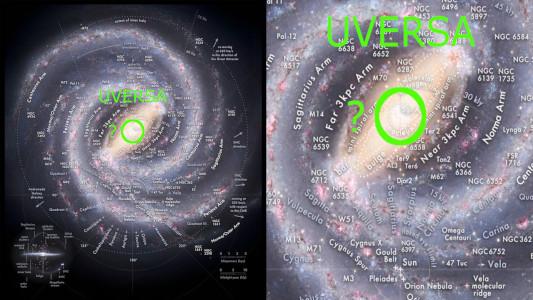Autor: Sławomir Żydenko
Searching
Welcome to another post about exploring mysteries from the Urantia Book in the field of astronomy. Today we will be discussing an object called Uversa. I will quote a passage from the Urantia Book from Paper number 15 for this purpose. Please listen to it.
„15:7.1 (174.1) While each superuniverse government presides near the center of the evolutionary universes of its space segment, it occupies a world made to order and is peopled by accredited personalities. These headquarters worlds are architectural spheres, space bodies specifically constructed for their special purpose. While sharing the light of near-by suns, these spheres are independently lighted and heated. Each has a sun which gives forth light without heat, like the satellites of Paradise, while each is supplied with heat by the circulation of certain energy currents near the surface of the sphere. These headquarters worlds belong to one of the greater systems situated near the astronomical center of their respective superuniverses.”
https://www.urantia.org/urantia-book-standardized/paper-15-seven-superuniverses
The description of Uversa is interesting. From this description, it appears that this is not a typical celestial body, it is “a world made to order”.
Error in the Urantia Book – distance to Uversa.
While searching for the answer to the question about the location of Uversa, I discovered an error.
In Paper number 32 we come across a quotation concerning the distance to Uversa. It is interesting in that specific distances are given. However, there is a problem here:
“32:2.11 (359.8) The Satania system of inhabited worlds is far removed from Uversa and that great sun cluster which functions as the physical or astronomic center of the seventh superuniverse. From Jerusem, the headquarters of Satania, it is over two hundred thousand light-years to the physical center of the superuniverse of Orvonton, far, far away in the dense diameter of the Milky Way. Satania is on the periphery of the local universe, and Nebadon is now well out towards the edge of Orvonton. From the outermost system of inhabited worlds to the center of the superuniverse is a trifle less than two hundred and fifty thousand light-years.”
https://www.urantia.org/urantia-book-standardized/paper-32-evolution-local-universes
Just a word of explanation of what Satania is. Satania is a relatively small administrative unit to which we belong, and it is part of Nebadon. Below is a link to a post in which I analyse what space Nebadon occupies.
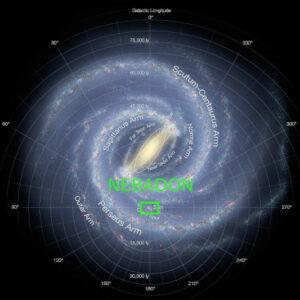
Nebadon is only a small fragment of the galactic disk. Satania, on the other hand, is a small fragment of Nabadon.
Link to an analysis of what space Nebadon occupies:
https://urantia.online/en/urantia-is-earth-nebadon-is-fragment-of-the-milky-way/
In the quote above, we read that:
- Satania, which is the relatively small administrative unit to which we belong, is located more than two hundred thousand light years from the centre of the Milky Way.
- In the next sentence we learn that we are on the edge of the inhabited part of the superuniverse of Orvonton, or the Milky Way.
- And in the last sentence we learn that from the edge of the inhabited part of the superuniverse of Orvonton, to its centre, is no more than two hundred and fifty thousand light years.
And this is where nothing is quite right. Firstly, from our vicinity, there is no more massive cluster of matter within the radius given than the centre of the Milky Way, and it is about twenty-five thousand light years away.
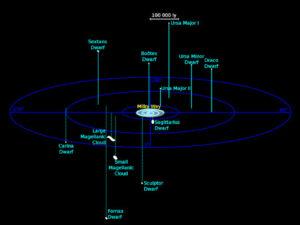
Satellite galaxies with the Milky Way in the middle. The slice of space visible in the illustration is about 1,000,000 light years in diameter. In this space, it is the Milky Way that is the largest cluster of matter.
Secondly, it is clear from the Milky Way diagram that in the direction outwards from us the number of stars begins to decrease and that it is quite possible that we live on the edge of the habitable centre of the Milky Way.
And thirdly, we have a repetition of an argument already used once, namely that, according to astronomical data, we are about twenty-five thousand light years away from the centre of the Galaxy, not two hundred and fifty thousand light years away, as it is written in the Urantia Book in the passage above.
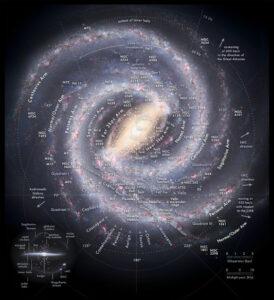
The Milky Way. According to current astronomical knowledge, the center of the Milky Way is about 25,000 light years away.
One possible explanation for the error
It seems to me that the reason for these inaccuracies is easy to explain. The Urantia Book was written in English, and in that language hundreds are often used interchangeably with thousands. For example, one thousand may be rendered as ten hundred, one thousand five hundred as fifteen hundred and so on. Arguably, instead of thousands, there should be hundreds in the text. If we were to assume that such an error crept in at some stage in the preparation of the Urantia Book for printing, everything would become clear, and the distances would immediately agree.
Read again the last quotation after the correction I made (the passages corrected by me are in bold):
“The Satania system of inhabited worlds is far removed from Uversa and that great sun cluster which functions as the physical or astronomic center of the seventh superuniverse. From Jerusem, the headquarters of Satania, it is over two hundred hundred (or twenty thousand) light-years to the physical center of the superuniverse of Orvonton, far, far away in the dense diameter of the Milky Way. Satania is on the periphery of the local universe, and Nebadon is now well out towards the edge of Orvonton. From the outermost system of inhabited worlds to the center of the superuniverse is a trifle less than two hundred and fifty hundred (or twenty-five thousand) light-years.”
If the distances in the text had been written in figures, one might have thought that a zero had been added erroneously at some stage. Such errors are not unusual in book preparation.
Centre of the Milky Way
The exact location of Uversa, unfortunately, we cannot deduce either from this quotation or from any other in the Urantia Book. All we know is that Uversa is located near the centre of the superuniverse of Orvonton. From the previous post, as well as from this one, it follows the superuniverse from Orvonton, we live in, is the Milky Way.
Link to a post about Orvonton:
https://urantia.online/en/orvonton-is-the-milky-way-subgroup/
As far as we know, the most central object in the Milky Way is a black hole called Sagittarius A* (for short Sgr A*), which is the centre of a larger structure called Sagittarius A. The whole thing is located in the Sagittarius constellation at a distance of 27900 light years from Earth. There is a suggestion in the above quote that Uversa is close to the centre of the superuniverse of Orvonton, but it does not say exactly which object it is. The Urantia Book states that it is “a world made to order”. In contrast, Sagittarius A*, the black hole at the centre of our Galaxy, appears to be a naturally formed object due to gravitational forces. So let’s assume that it is some object located in the centre of the Galaxy, near Sagittarius A*.
https://en.wikipedia.org/wiki/Sagittarius_A
https://en.wikipedia.org/wiki/Sagittarius_A*
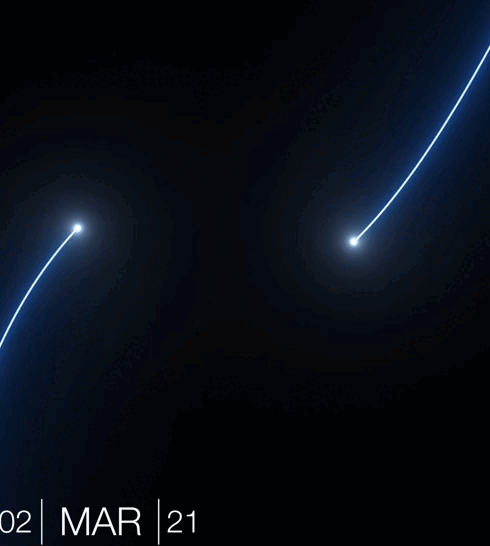
Take a look at the stars orbiting the object Sagittarius A* from the Wikipedia page. These images have enabled its precise location. This object is naturally absorbing matter around it all the time, so it is still in the process of being created.
https://en.wikipedia.org/wiki/Sagittarius_A*
And now for another photo of the centre of the Milky Way:
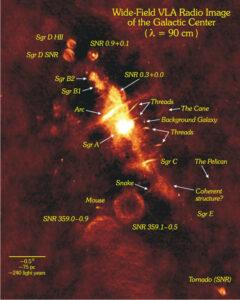
Photo of the center of the Milky Way. Sgr stands for Sagittarius.
https://en.wikipedia.org/wiki/Sagittarius_A
And on the diagram of the Galaxy:

The diagram of the Milky Way.
https://en.wikipedia.org/wiki/Galactic_Center
By Pablo Carlos Budassi – Own work, CC BY-SA 4.0,
https://commons.wikimedia.org/w/index.php?curid=102333184
Definition
After confronting the data from the Urantia Book and publicly available scientific data, we conclude that Uversa is located at the centre of our Galaxy. The location of Uversa can, in my opinion, only be given indicatively. I don’t think it is possible to pinpoint the exact location of this object and call it by its current name.
Based on the above, I would define the Uversa object as follows: An object in the centre of the Milky Way, most likely nearby the Sagittarius A*.
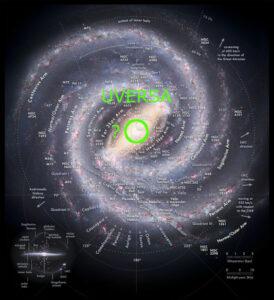
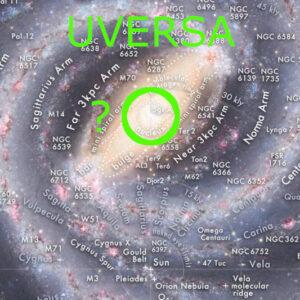
Uversa is at the centre of our Galaxy. In the sky it is somewhere in Sagittarius, where the greatest density of stars is.
Final words
My dear viewers, at this point I will end this post. I have material prepared for the next post. Next time we’ll talk about the grand universe, Havona and about the Isle of Paradise.
In the meantime, I say goodbye to you. Please write in the comments what you think about this.
Link to the video:
Link to the first part:
https://urantia.online/en/god-the-universe-and-other-planets-the-urantia-book-foreword_1/
Link to the second part:
https://urantia.online/en/urantia-is-earth-nebadon-is-fragment-of-the-milky-way/
Link to the third part:
https://urantia.online/en/orvonton-is-the-milky-way-subgroup/
Facebook:
https://www.facebook.com/slawomir.zydenko/
Quotes sources:
https://www.urantia.org/urantia-book-standardized/paper-15-seven-superuniverses
https://www.urantia.org/urantia-book-standardized/paper-32-evolution-local-universes
https://en.wikipedia.org/wiki/Sagittarius_A
https://en.wikipedia.org/wiki/Sagittarius_A*
https://en.wikipedia.org/wiki/Galactic_Center
https://commons.wikimedia.org/w/index.php?curid=102333184
Source of thumbnail graphics:
https://en.wikipedia.org/wiki/Galactic_Center
Support:

